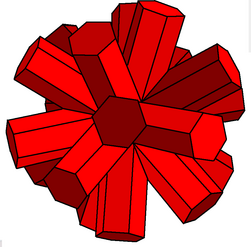Small_dodecahemicosacron
Small dodecahemicosacron
Polyhedron with 30 faces
In geometry, the small dodecahemicosacron is the dual of the small dodecahemicosahedron, and is one of nine dual hemipolyhedra. It appears visually indistinct from the great dodecahemicosacron.
| Small dodecahemicosacron | |
|---|---|
 | |
| Type | Star polyhedron |
| Face | — |
| Elements | F = 30, E = 60 V = 22 (χ = −8) |
| Symmetry group | Ih, [5,3], *532 |
| Index references | DU62 |
| dual polyhedron | Small dodecahemicosahedron |
Since the hemipolyhedra have faces passing through the center, the dual figures have corresponding vertices at infinity; properly, on the real projective plane at infinity.[1] In Magnus Wenninger's Dual Models, they are represented with intersecting prisms, each extending in both directions to the same vertex at infinity, in order to maintain symmetry. In practice the model prisms are cut off at a certain point that is convenient for the maker. Wenninger suggested these figures are members of a new class of stellation figures, called stellation to infinity. However, he also suggested that strictly speaking they are not polyhedra because their construction does not conform to the usual definitions.
Since the small dodecahemicosahedron has ten hexagonal faces passing through the model center, it can be seen as having ten vertices at infinity.